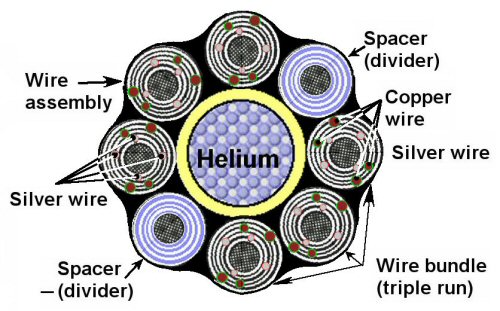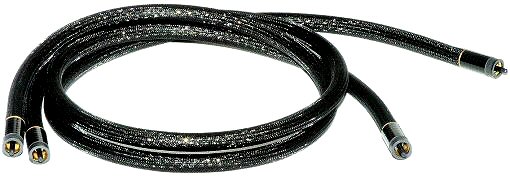Stealth Audio Cables
| Stealth Audio Cables |
| Sonic Flavors For Every Taste |
|
|
|
April 2008 |

Back in May of 2007 I suffered a mild heart attack that forced me to spend a lot of time relaxing at home and off the golf course. Ordinarily, the summer is not a time that I like to find myself at home, especially when there are perfectly good fairways out there for me to hack up. But doctor’s orders are doctor’s orders, so off to the sofa I went. It was around that time that I received a shipment of cables from Serguei Timachev of Stealth Audio for evaluation.
I had been trading emails with Timachev for a few months following the 2007 CES. He was gathering information from me on my current reference system, the cables I was using and the sonic results I was getting. Usually, when dealing with a cable designer, they don’t ask you about your sonic tastes. They simply introduce you to their design philosophy, have you install their cables into your system, and only then do you know what the cables will (or won’t) do in your system. But with Timachev it was different. He introduced me to the idea that listening to different cables was like experiencing “different sonic flavors.” “Neutral is a subjective thing,” said Timachev. “It is system and personal taste dependant. That’s why there are so many cables in the Stealth Audio line.” Actually, according to their website, there are seven different analog interconnects, five digital interconnects, seven speaker cables, and five power cords. Different strokes, for different folks as they say.
What a wonderful approach to designing a line of cables. Many cable makers saturate the market with their top-of-the-line, second mortgage busting, “reference” or “master” or “master reference” or “reference master” cables, then later come out with an affordably priced cable that they say will give you about 85% of the performance of the best available cables for only 50% of the price. In reality, all they did was make a cable using different types or amounts of materials which result in cables with different sonic attributes; not always better or worse, just different. I’ve heard a line of cables where the so-called “entry level” cables represented a better sonic and economic value than did the top-of-the-line cables. This wasn’t because the pricier cables weren’t better made, they were. It was because the sonic qualities of the less expensive cables suited my system and listening tastes better. This is why Stealth Audio has been so successful. They design cables not to suit a specific price point, but to suit a particular type of sound.
Stealth makes a full compliment of cables made with different combinations of pure silver, gold, and carbon. Timachev wanted to make sure that I had a very well rounded experience, so the cables he sent me, the PGS-XL-UB, Nanofiber, Metacarbon, Air King, and GS50-50 interconnects are all designed to have distinctively different sonic flavors. He also sent along a pair of speaker cables called the Dream Petite which is a smaller version of their top-of-the-line Dream speaker cable.
Dream Petite and Metacarbon: A Neutral Reference Point
Since the Dream Petite was the only speaker cable I was sent, I decided to work it into the system first followed by two balanced pairs of the Metacarbon interconnects: one pair from the digital source to the preamp and the other from the preamp to the power amp(s). This will help me establish a reference point for the other cables I would use. The excellent Virtual Dynamics Nite II and Argento Serenity cables have long been my reference, so the Dream Petite and Metacarbon had some large shoes to fill.
As I mentioned before, it’s been my experience that different cables simply offer different sounds, and whether that sound is better or worse than another is subjective. What’s not subjective is the quality of design and construction of the cables, and in this regard the Stealth cables are top-notch.

The Dream Petite cable is comprised of six wire assemblies and two spacers (photo above). Each wire assembly is ¼” in diameter, made of eight individually insulated solid core wires in a proprietary non-resonant distributed LITZ configuration; two different gauges of 99.999% pure solid core copper, and two different gauges of 99.997% pure solid core silver are used in each wire assembly. The wire assemblies are wrapped around a hollow, flexible Helium-filled tube. Three of the wire assemblies are run side-by-side to create a triple run wire bundle. Therefore, there are two triple run wire bundles in each Dream Petite cable. The two wire bundles are separated by two soft ¼” Teflon spacers. The spacers reduce cable capacitance which assures stability of any amplifier. The whole cable is wrapped in a thin and understated looking nylon jacket and terminated with spade connectors.

The Metacarbon (short for metallized carbon) is a cable that was designed to be a more affordable alternative of Stealth’s highly regarded Indra cable. The metallization technique tries to get to the best treble performance possible by maintaining the purity, neutrality and other benefits of the pure carbon signal path. The proprietary connectors used with these cables are similar to those of the Indra (pure silver hollow thin wall pins for both RCA and XLR), but the Carbon/Titanium RCA outer shells on the Metacarbon cables feature three stripes color coding for a distinctive look. It’s the perfect compliment to the Dream Petite not just in price but in sonic character.
Both cables are very neutral sounding and should make it easy for me to recognize the different aspects of sound from the other cables.
 Before I go any further, it’s worth mentioning that both of my current reference cables (Virtual Dynamics and Argento) are older models that have since been improved upon, but both are excellent performers. Still, the Stealth cables provided an immediate improvement over the soundstaging abilities of the Virtual Dynamics Nite II and the three-dimensionality of the Argento Serenity. Proof of that was laid out in front of me when I listened to Erin Bode’s “Holiday” from her CD Over and Over[Max Jazz MXJ 121]. This was the tune that I played in room after room at the 2008 CES, so I knew it well and it never sounded better. Bode’s voice sounded more lifelike and breathy through the Stealth cables and even the bass sounded more tight and tuneful. I got the same result while listening to Nora Jones sing Joni Mitchell’s classic, “Court and Spark” on Herbie Hancock’s wonderful Grammy-winning CD, River: The Joni Letters [Verve]. Her voice took on a bluesy texture that was a perfect balance to against Hancock’s razor sharp piano accompaniment.
Before I go any further, it’s worth mentioning that both of my current reference cables (Virtual Dynamics and Argento) are older models that have since been improved upon, but both are excellent performers. Still, the Stealth cables provided an immediate improvement over the soundstaging abilities of the Virtual Dynamics Nite II and the three-dimensionality of the Argento Serenity. Proof of that was laid out in front of me when I listened to Erin Bode’s “Holiday” from her CD Over and Over[Max Jazz MXJ 121]. This was the tune that I played in room after room at the 2008 CES, so I knew it well and it never sounded better. Bode’s voice sounded more lifelike and breathy through the Stealth cables and even the bass sounded more tight and tuneful. I got the same result while listening to Nora Jones sing Joni Mitchell’s classic, “Court and Spark” on Herbie Hancock’s wonderful Grammy-winning CD, River: The Joni Letters [Verve]. Her voice took on a bluesy texture that was a perfect balance to against Hancock’s razor sharp piano accompaniment.
So now that I have some neutral sounding interconnects and speaker cables in place, I could finally get down to the business of sampling the “sonic flavors” in Stealth Audio’s vaunted interconnect line up: the GS50-50, Air King, Nanofiber and PGS-XL-UB. Balanced (XLR) pairs of GS50-50, Air King, and Nanofiber cables will be rotated into the system behind the Metacarbon (from CD player to linestage and linestage to amps), and a unbalanced (RCA) PGS-XL-UB and will be used from tuner to linestage. The PGS-XL-UB has recently been replaced by the PGS-08, said to be similar in character to the previous cable but with more “slam and authority.”
GS50-50

GS50-50 cables are not a mix of gold and silver wires but a proprietary solid core alloy wire comprised of 50% pure gold and 50% pure silver manufactured to Stealth’s specifications using the continuous casting process that I first saw used in the Vampire Wire copper cables I used to use years ago. They came sheathed in an attractive “gold-silver” (light gold) mesh jacket and use ultra-high quality XLR connectors from Neutrik of Switzerland. The sonic flavor of the GS50-50 would have to be characterized as smooth. This cable exhibited the least amount of change from the Metacarbon and that’s a good thing.  The Metacarbon’s strength is in its neutrality and if you’re a lover of acoustic music this should excite you. For example, guitarist Antonio Forcione and singer Sabina Sciubba’s Meet Me In London [naimcd021] is loaded with wonderfully recorded songs that show off Forcione’s brilliance on acoustic guitar. Particularly on track 2, a remake of Dave Brubeck’s timeless “Take Five.” The GS50-50 doesn’t add any audible artifacts, leaving the strumming of strings and popping of the guitar’s body sounding realistic and not studio enhanced. This cable renders acoustic music naturally.
The Metacarbon’s strength is in its neutrality and if you’re a lover of acoustic music this should excite you. For example, guitarist Antonio Forcione and singer Sabina Sciubba’s Meet Me In London [naimcd021] is loaded with wonderfully recorded songs that show off Forcione’s brilliance on acoustic guitar. Particularly on track 2, a remake of Dave Brubeck’s timeless “Take Five.” The GS50-50 doesn’t add any audible artifacts, leaving the strumming of strings and popping of the guitar’s body sounding realistic and not studio enhanced. This cable renders acoustic music naturally.
Air King
You probably don’t have to guess what flavor the pure silver designed Air King is intended to impart. That’s right, more “air.” Does it deliver? Boy I’ll say. It usually takes a lot for me to enjoy live recordings of large scale orchestral work. But when I installed the Air King and began listening to Michelle DeYoung and the Chicago Symphony Orchestra’s recording of Mahler:Symphony No.3 [CSO Resound], I immediately appreciated Stealth’s approach to designing cables to present music in different ways. The Air King let this recording expand across the width and depth of the soundstage, presenting the music in a very realistic space, a very huge space. My Escalante Design Fremonts were already a rather large sounding speaker, but with the Air King connecting the Classe CDP-502 CD player to my BAT VK31SE preamp they were now receiving a source signal that brought additional clarity and focus to the music and gives you a sense of the immensity of Chicago’s famed Orchestra Hall. In other words the Air King cables give you more of that “your are there” flavor.
Nanofiber

The Nanofiber interconnect is composed of ultra-thin conductive carbon fibers that are integrated into the center pins in Stealth’s own unbalanced (RCA) and balanced (XLR) connectors. There is absolutely no metal in the signal path. The return however is made of multiple thin OFC strands in both RCA and XLR configurations. A benefit of this design is that the Nanofiber cables are as silent and hum-free as the best all-metal cables. The result is a somewhat softer, more laidback presentation.  The impact is similar to that of installing classic Quad ESLs into your system. This cable may not be the cup of tea for metal or funk enthusiasts. I tried listening to Patricia Barber’sLive: A Fortnight In France[Blue Note] and couldn’t stay awake. This may have more to do with the fact that my system is already to the mellow side of neutral and these cables are softer still. But when I swapped out the BAT VK1000 mono amps for the ASR Emitter II integrated amp it was like magic. The ASR is a far better and faster sounding amp than the relatively big and sluggish BAT amps, and used in a system with silver cables can make a system sound bright. But the Nanofibers loved this amp because it extracted the best performance out of them. While the basic character was still sort of laid back, there was also considerably more definition to the vocals and instruments bringing the subdued atmosphere even more alive without adding any splash or edge. Again, the Stealth line of cables gives you more flexibility in system matching.
The impact is similar to that of installing classic Quad ESLs into your system. This cable may not be the cup of tea for metal or funk enthusiasts. I tried listening to Patricia Barber’sLive: A Fortnight In France[Blue Note] and couldn’t stay awake. This may have more to do with the fact that my system is already to the mellow side of neutral and these cables are softer still. But when I swapped out the BAT VK1000 mono amps for the ASR Emitter II integrated amp it was like magic. The ASR is a far better and faster sounding amp than the relatively big and sluggish BAT amps, and used in a system with silver cables can make a system sound bright. But the Nanofibers loved this amp because it extracted the best performance out of them. While the basic character was still sort of laid back, there was also considerably more definition to the vocals and instruments bringing the subdued atmosphere even more alive without adding any splash or edge. Again, the Stealth line of cables gives you more flexibility in system matching.
I won’t dwell a lot on the PGS-XL-UB cables since they are no longer current. Besides, the Chicago-area National Public Radio affiliate (WBEZ 91.5 FM) recently discontinued much of its great Sunday morning jazz programming, so I don’t listen to FM broadcasts nearly as much as I used to. But the PGS-XL-UB was a very good cable and I’m intrigued by just how much better the PGS-08 might be. These cables did a great job of getting a strong signal out of my Magnum Dynalab DT-5 AM/FM digital tuner. The clarity of the signal was as good as the Virtual Dynamics cable though not quite as good as the Argento Serenity, which is a silver design as opposed to the pure gold signal (PGS) wired Stealth design. Still, it’s a fine sounding cable and might be had at a bargain price used now that it’s been discontinued.
Conclusion
It took a while for me to get all of these excellent cables into my system and spend enough time letting them settle in and trying them in multiple system configurations. I tried to make my comments on each as concise as possible because going into great detail on each cable in each different configuration that I used would call for writing a review that would rival War & Peace in its length. As I’ve learned over the years of writing reviews for the internet, no one wants to look at a computer screen for that long. So I’ve tried to make this review relatively brief.
But I must say that Serguei Timachev has the right idea in designing cables to produce different sonic results (flavors) and he has an adept touch for combining the right materials and techniques for producing such products. I will not say that any one cable is definitively better than another, though for my own personal tastes I found the Air King to be something special and you can never go wrong with the neutrality of the Metacarbon interconnects and speaker cables. But I will say that depending on your personal tastes and what you value sonically, there’s no doubt that Stealth Audio makes a cable that can more than satisfy your audio palate. Highly recommended.

####
Technical Specifications:
Dream Petite – Multi-core, multi-layer, silver-copper hybrid, para-vacuum dielectric
Metacarbon – Metallized carbon signal wire with custom titanium/carbon RCA and XLR connectors
Air King – Ultra thin solid core silver wire.
GS50-50 – Proprietary monocrystal alloy wire (50% pure gold, 50% pure silver) w/ultra-light Teflon/silver connectors
Nanofiber – Thin conductive carbon fibers integrated into the connector center pins, with OFC shield and proprietary connectors
PGS-XL-UB – Pure 99.99% solid core gold signal wire
Price:
Dream Petite – $7,700/3m pair
Metacarbon – $3,300/1m (RCA), $4,300/1m (XLR)
Air King – $1,900/1m (RCA), $2,500/1m (XLR)
GS50-50 – $2,000/1m (RCA), $2,600/1m (XLR)
Nanofiber – $2,600/1m (RCA), $3,400/1m (XLR)
PGS-XL-UB – $1,000/im (RCA), $1,300/1m (XLR) (discontinued)
Stealth Audio
Interlink House
17528 Bowie Mill Road
Derwood, MD 20855
Phone: 800-579-4046
Email: stealth@stealthaudiocables.com
Website: http://www.stealthaudiocables.com/
![]()
Don’t forget to bookmark us! (CTRL-SHFT-D)
Stereo Times Masthead
Publisher/Founder
Clement Perry
Editor
Dave Thomas
Senior Editors
Frank Alles, Mike Girardi, Russell Lichter, Terry London, Moreno Mitchell, Paul Szabady, Bill Wells, Mike Wright, and Stephen Yan,
Current Contributors
David Abramson, Tim Barrall, Dave Allison, Ron Cook, Lewis Dardick, John Hoffman, Dan Secula, Don Shaulis, Greg Simmons, Eric Teh, Greg Voth, Richard Willie, Ed Van Winkle, Rob Dockery, Richard Doran, and Daveed Turek
Site Management Clement Perry
Ad Designer: Martin Perry





Be the first to comment on: Stealth Audio Cables